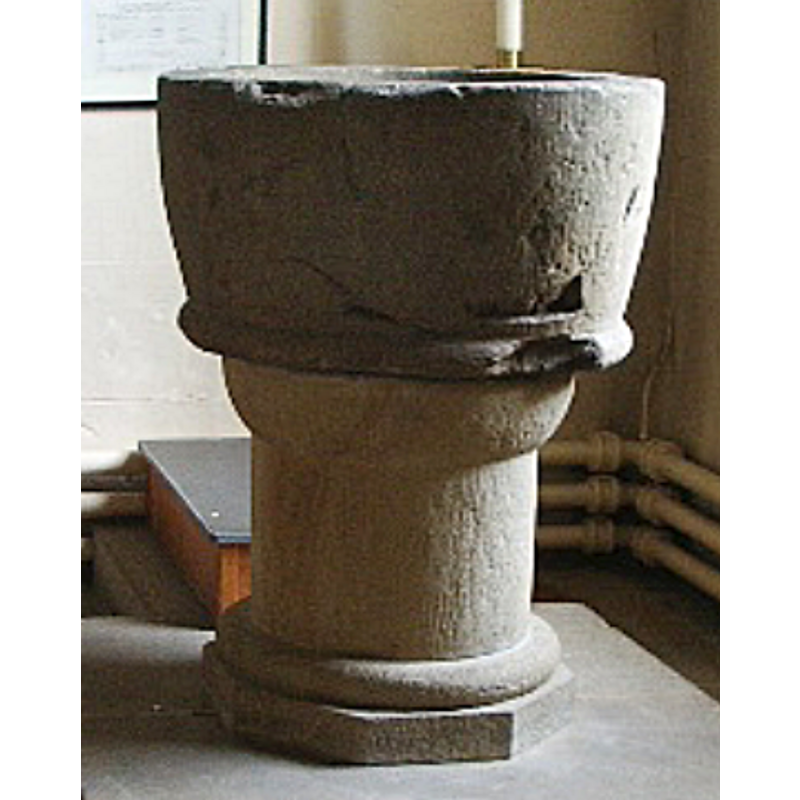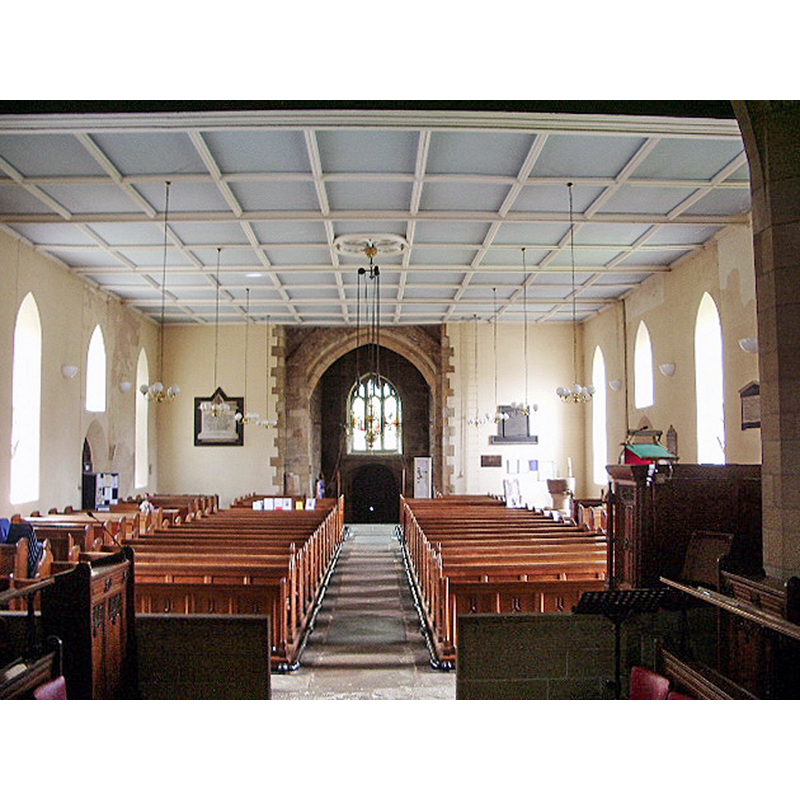Broughton nr. Preston / Brecton / Brocton / Broctun / Broghton / Brogton / Broucton / Broughton-in-Amounderness

Image copyright © Alexander P Kapp, 2008
CC-BY-SA-2.0
Results: 4 records
design element - motifs - roll moulding
Scene Description: showing the damage to the side and moulding
Copyright Statement: Image copyright © Alexander P Kapp, 2008
Image Source: edited detail of a digital photograph taken 30 June 2008 by Alexander P Kapp [www.geograph.org.uk/photo/866639] [accessed 20 March 2019]
Copyright Instructions: CC-BY-SA-2.0
view of church exterior - northeast view
Scene Description: Sorce caption: "The Parish Church of St John the Baptist, Broughton. The exact date of the establishment of a church at Broughton is not known but is believed it to be about 1100 AD [...] The earliest building was probably wooden but there seems to have been a stone church in the fourteenth century. This was rebuilt in 1533 – the date of the tower which is the oldest part now standing. The church was rebuilt again in 1826 and in 1904 the east wall was removed and the present chancel added. Other more recent additions have been the choir vestry on the south side in 1976 and a north porch in 1987."
Copyright Statement: Image copyright © David Dixon, 2011
Image Source: digital photograph taken 26 July 2011 by David Dixon [www.geograph.org.uk/photo/2528459] [accessed 20 March 2019]
Copyright Instructions: CC-BY-SA-2.0
view of church interior - nave - looking east
view of font in context
Scene Description: the 12thC (?) basin on a modern pedestal base and two-step plinth
Copyright Statement: Image copyright © Alexander P Kapp, 2008
Image Source: digital photograph taken 30 June 2008 by Alexander P Kapp [www.geograph.org.uk/photo/866639] [accessed 20 March 2019]
Copyright Instructions: CC-BY-SA-2.0
INFORMATION
FontID: 14383BRO
Object Type: Baptismal Font1
Church/Chapel: Parish Church of St. John the Baptist
Church Patron Saints: St. John the Baptist
Church Location: Church Ln, off Garstang Rd, Preston PR3 5JB, UK -- Tel.: 01772 713880
Country Name: England
Location: Lancashire, North West
Directions to Site: Located off the A6, 5 km WNW of Preston, near the M6-M55 junction
Ecclesiastic Region: Diocese of Blackburn
Historical Region: Hundred of Amounderness
Font Location in Church: Inside the church, in the NW corner of the nave [originally in the W end of the S aisle]
Century and Period: 12th century [basin only], Medieval [composite]
Cognate Fonts: Rochdale?
Font Notes:
Click to view
There is an entry for this Broughton [variant spelling], together with dozens of other places in the Domesday survey [https://opendomesday.org/place/SD5234/broughton/] [accessed 20 March 2019]; it mentions three churches in it. Fishwick (1900) writes: "the font, which in 1826 was taken out of the church and an alabaster one substituted for it ; the present vicar discovered it in 1889, at Barton cottage, and restored it to its place. It is of considerable antiquity — certainly as old as the foundation of the church, and may possibly be very much older. Its dimensions are 2ft. 8 in. outside, and 2 ft. i in. inside diameter, thus leaving a rim or border 2i in-; it is in depth 18 in. outside, and 1 1 in. inside. It is made out of a sandstone boulder and is not perfectly round and has the appearance of being hatched work, the only attempt at ornamentation is a narrow bead running round the bottom […] the rim are the two holes where staples were let in, to which the lid or cover was attached, and at the bottom is the hole for the disused water to be let off […] A font very similar to this was found in the churchyard of the Rochdale Parish Church, in 1893.' There was an old tradition about the Broughton font, to the effect that there was a miraculous periodical overflow of the water left in it, and people came from the surrounding districts to be cured of king's evil by its application. The apparent supernatural phenomenon was explained by the fact that the waste water was carried into a bed of gravel." This same source notes the discovery of an old holy-water stoup: "In a ditch bottom near the church in 1893, was found a small octagonal stoup for holy water, which no doubt belonged to the pre-reformation church; its dimensions are yi in. high and 8 in. diameter, the bottom part is 4.1 in. diameter." The entry for this township in the Victoria County History (Lancaster, vol. 7, 1912 ) notes: "Though the building building [...] existed from an early time, there are few records of it. [...] In the 16th century it was often called a church, its status being that of parochial chapel. [...] The site is an ancient one, but the oldest part of the present church is the tower, which dates only from the 16th century, the rest being modern. The old building, which was pulled down about 1823, appears to have been an early 16th-century rebuilding of a 14th-century church, fragments of which have been discovered, [...] and it is probable that at least two churches stood on the site previous to the reign of Henry VIII. [...] The font which stands in the north-west corner of the nave, is a massive circular Norman bowl 2 ft. 8½ in. in diameter and 18 in. high, hewn out of a sandstone boulder, with a half-round moulding at the bottom. The font was turned out of the church in 1826 to make way for one of alabaster, but was discovered at a cottage in Barton in 1889 and restored to the church. The bowl is supported by a modern shaft. There are preserved in the church an old stoup, [....] an octagonal stone mortar [...] [f]ound in 1893 in a ditch near the church". The font, which stands in the north-west corner of the nave, is a massive circular Norman bowl 2 ft. 8½ in. in diameter and 18 in. high, hewn out of a sandstone boulder, with a half-round moulding at the bottom. The font was turned out of the church in 1826 to make way for one of alabaster, but was discovered at a cottage in Barton in 1889 and restored to the church. The bowl is supported by a modern shaft." [NB: the plan of the church from before 1823 illustrated in the VCH shows a font in the west end of the south aisle]. An old stoup is also reported in the VCH: "Found in 1893 in a ditch near the church". [NB: the font shown in the You Tube short film [cf. note below] consists of a plain bucket-shaped basin on (later?) moulded base. The old basin was probably discarded at some point and later rescued and re-installed in the church. The entry for this church in Historic England [Listing NGR: SD5289934373] notes: "Parish church [...] Probably 3rd church on site since C12. [...] West tower dated 1533, nave rebuilt 1822, chancel and attached offices 1906 [...] tub font (removed in early C19 and used as flower vase, but restored here in 1887, on new pedestal) said to be Saxon." Noted in Hartwell & Pevsner (2009): "A big rough bowl of unknown date."
COORDINATES
Church Latitude & Longitude Decimal: 53.80344, -2.7169
Church Latitude & Longitude DMS: 53° 48′ 12.38″ N, 2° 43′ 0.84″ W
UTM: 30U 518644 5961690
MEDIUM AND MEASUREMENTS
Material: stone, sandstone
Font Shape: tub-shaped (mounted)
Basin Interior Shape: round
Basin Exterior Shape: round
Diameter (inside rim): 63.5 cm*
Diameter (includes rim): 81.28 cm* / 82.55 cm**
Basin Depth: 27.94 cm*
Basin Total Height: 45 cm* / 45.72 cm**
Notes on Measurements: * in inches in Fishwick (1900) / ** in inches in the VCH (1912)
REFERENCES
Victoria County History [online], University of London, 1993-. Accessed: 2009-03-30 00:00:00. URL: https://www.british-history.ac.uk.
Fishwick, Henry, The History of the Parish of Preston in the County of Lancaster, Rochdale; :ondon: James Clegg, Aldine Press; Elliot Stock, 1900
Hartwell, Clare, Lancashire North, New Haven; London: Yale University Press, 2009

![Sorce caption: "The Parish Church of St John the Baptist, Broughton. The exact date of the establishment of a church at Broughton is not known but is believed it to be about 1100 AD [...] The earliest building was probably wooden but there seems to have been a stone church in the fourteenth century. This was rebuilt in 1533 – the date of the tower which is the oldest part now standing. The church was rebuilt again in 1826 and in 1904 the east wall was removed and the present chancel added. Other more recent additions have been the choir vestry on the south side in 1976 and a north porch in 1987."](/static-50478a99ec6f36a15d6234548c59f63da52304e5/compressed/1190320012_compressed.png)
